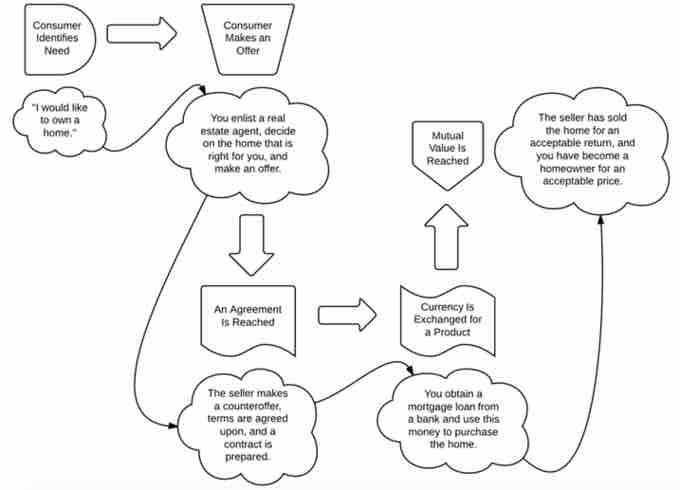The Marketing Exchange
The exchange process is the act of obtaining a desired object from someone by offering something of value in return. The exchange between the person in need (i.e., someone who offers money or some other personal resource) and the organization selling the product, service, or idea results in a transaction. The top goal of any marketing organization is to facilitate and help increase sales transaction by convincing potential consumers and existing customers to buy their company's product or service.
With the emergence of the Internet and e-commerce during the 1990s, the nature of the marketing exchange for businesses and customers has changed drastically. Today's consumers have access to far more and far better information. They also have many more choices. Businesses must provide personalized, relevant and high quality content that competes with a fast, ever-changing competitive landscape. .
Amazon Online Shopping
Online shopping and modern technology gives consumers access to unlimited information and product choices. Marketers must take into account technology's impact in order to foster successful market exchanges.

Simple Marketing Exchange
This flow chart depicts a simple commercial exchange.
Trade-Off Analysis
The exchange process allows the parties to assess the relative trade-offs they must make to satisfy their respective needs and wants. For the marketer, analysis of these trade-offs is guided by company policies and objectives. For example, a company may engage in exchanges only when the profit margin is 10% or greater. Buyers also have personal policies and objectives that guide their responses in an exchange. Unfortunately, buyers seldom write down their personal policies and objectives. Even more likely, they often do not understand what prompts them to behave in a particular manner. This is the mystery, or the "black box," of buyer behavior that makes the exchange process so unpredictable and difficult for marketers to understand.
Marketers can, however, attempt to understand the qualities of their products and how consumers view these qualities in relation to their perceived benefit. One such technique to understand this consumer behavior is known as perceptual mapping, which is a technique that uses diagrams in an attempt to visually display the perceptions of consumers. These ideas will be explored in greater detail in later chapters.
Negotiation
There tends to be some negotiation between the parties in the exchange process. Individuals on both sides attempt to maximize rewards and minimize costs in their transactions so as to obtain the most profitable outcomes. Ideally, all parties achieve a satisfactory level of reward.
In each transaction, there is an underlying philosophy in respect to how the parties perceive the exchange. Sometimes deception and lying permeate the exchange. Other exchanges may be characterized as equitable, where each party receives about the same as the other—the customer's need is satisfied and the business makes a reasonable profit.

Complex Marketing Exchange
This flow depicts a more complex commercial exchange.
Understanding Buyer Behavior Will Jumpstart the Exchange Process
When we use the term "buyer", we are referring to an individual, group, or organization that engages in market exchange. In fact, there are differences in the characteristics of these three entities and how they behave in an exchange. Therefore, individuals and groups are traditionally placed in the consumer category, while organizations are placed in the second category.
When potential buyers are not satisfied, the exchange falters and the goals of the marketer cannot be met. As long as buyers have free choice and competitive offerings from which to choose, they are ultimately in control of the marketplace.
The potential buyers, in commercial situations, "vote" (with their dollars) for the market offering that they feel best meets their needs. An understanding of how they arrive at a decision allows the marketer to build an offering that will attract buyers. Two of the key questions that a marketer needs to answer relative to buyer behavior are:
- How do potential buyers go about making purchase decisions?
- What factors influence their decision process and in what way?
The answers to these two questions form the basis for target market selection, and, ultimately, the design of a market offering.
Purchase Decisions
In order to better understand the marketing exchange, it is important for marketers to grasp how consumers go about making purchase decisions. In general, the consumer decision process includes the following steps:
- Need recognition
- Information search
- Evaluation of alternatives
- Purchase
- Post-purchase behavior
As the consumer moves through these various phases, internal and external conditions are influencing the consumer's actions throughout the purchasing process. Internal influences include beliefs, feelings, demographics, lifestyle, motivation, and personality. Psychological factors include an individual's perception, attitude and belief, while personal factors include income level, personality, age, occupation and lifestyle. For example, a consumer may enter the purchase decision stage for a particular product, but decide to buy a different brand after receiving negative feedback from a trusted friend.
Marketing also plays a role in how consumers perceive brand messaging through lenses such as culture, lifestyle and personality. For instance, brands can ensure that content and other messaging align with the individual consumer's personality profile and motives.
Marketers use a variety of promotional tools to "nudge" consumers who intend to buy but decide to purchase at a later time due to internal or external factors (e.g., loss of job, retail store closing, etc.). To successfully guide consumers through the buying process, marketers attempt to make products and services more appealing by offering credit or payment terms, sales promotions, rebates, and other premiums to convince consumers to buy now rather than later. Complimentary perks and services such as add-on features and lifetime warranties are other tactics used by brands to sell product and service benefits to consumers.